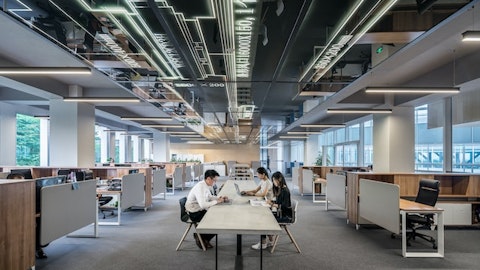Sabahat Khan: Okay. Great, thanks. And then just one on, I guess, the larger funding packages, you talked about some of the near-term growth or near to medium-term growth coming from the IIJA. Can you maybe talk us through which end markets you’re expecting to see? Maybe more of the support from the IIJA over the next, call it, 12 to 24 months. And maybe medium to longer term, we are hearing that funding probably accelerates over the next 12 to 18 months and plateaus for about three to four years. Is that directionally in line with your expectations of how the money flows as well? So maybe just a bit on the near-term and just your perspectives on how the longer term money comes. Thanks.
Troy Rudd: Yes. So just in terms of the end markets, our end markets that have been particularly strong for the last few quarters and have remained strong this quarter, and we see remaining strong again, driven by transportation, water and the environment business, we also see increasing opportunities in energy. And then as we look up through the next three years, as I said, we really are optimistic about our continued opportunity to grow, because while we see funding in the midterm lining up, we see some very good long-term trends. But most importantly, as I said a little bit earlier, is we’ve expanded our exposure to our client spends on project through program management advisory and that is significant. And based on our win rates, we’re taking market share and we don’t see that continuing to change.
As I said in the prepared comments, overall, for this is the 10th quarter where we’ve won at 50% or higher in terms of our win rates or capture rates. And on the larger programs or projects, we’re winning almost two out of every three times. So that indicates that we’re taking market share. And I think we’ve created an advantage that it’ll take a lot of time for others to replicate if they can.
Sabahat Khan: Thank you.
Operator: Your next question comes from the line of Sangita Jain with KeyBanc Capital Markets. Please go ahead.
Sangita Jain: Hi. Thank you so much for taking my question. So I want to go back to an earlier question that was asked on the momentum in the business with the strong U.S. book-to-bill the higher business development expense, the PFAS rulings. Should all these point to a higher sustainable revenue growth rate than the 8% that you’ve outlined? How should we think about that?
Troy Rudd: So, again, I wouldn’t think about this as long-term sustainable growth beyond the guidance that we given this year. What we said previously is that we think this year is a very good year for growth. We haven’t commented on the future. And so this year, our guidance has been 8% to 10%. We believe that over the long-term, and when I say long-term, we’re talking multiple years. Our guidance still remains between 5% and 8%. And we think that’s a reflection of the opportunity and the investment infrastructure, our exposure to clients’ budgets. And frankly, that’s taking market share. And so in the long-term, that’s where we sit. But the other important part of this is to think about this as margin improvement, because it’s a combination of the two that really, we think, create value.
Because as we continue to grow, we also will continue to invest heavily in the business and in the future and at the same time expand our margins. And so it really is the combination of the two that we think you should – again, I think you should think about, because you can certainly have a lot of growth in a business like this, but you can do it at declining margins. And we don’t think that that makes any sense.
Sangita Jain: Great. Thanks. That’s helpful. And on the PFAS rules that came out recently, and you talked about your backlog build in that, can you help us map it out in terms of revenue recognition and maybe average project size. And I also want to ask you about your destruction technology and how you’re marketing that.
Lara Poloni: I’ll take that. Thank you, Sangita. We’re still very optimistic about the opportunities with PFAS, and of course, we come from the market leading position there and we believe that what separates us from the peers at the moment is we have complete coverage going forward of the most important U.S. government contracts. So obviously, the new maximum containment level and the hazarded substance designations are both meaningful catalysts for us. But we’ve been positioning for these sort of legislative changes for quite some time and we’ve got the technical capability at global scale to mobilize there. But today it’s about 1% of our revenue. But we’re optimistic that there’s going to be substantial growth and NSR growth acceleration, and it has the potential to be two to three times bigger over the next few years for us.
Gaurav Kapoor: And Sangita, this is Gaurav. We don’t provide average contract size into these sub-disciplines.
Sangita Jain: Got it. Appreciate it. Thank you.
Troy Rudd: Thank you.
Lara Poloni: Thank you.
Operator: Your next question comes from the line of Vlad Bystricky with Citigroup. Please go ahead.
Vlad Bystricky: Good morning, everyone. Thanks for taking my call. So maybe just following up on that last question around the PFAS wins, can you just talk about sort of beyond the U.S. and North America, how you’re seeing PFAS regulations evolve and how you’re thinking about the potential for PFAS opportunities globally?
Lara Poloni: Sure, Vlad, I’ll take that. We – I mean, there are opportunities, certainly, of global scale, and what we’ve seen over the last few years is, in fact, that other parts of our international operations, for example, the European regs probably moved ahead faster than the pace that we’ve seen in the U.S. and certainly in Australia as well. They were quite advanced in terms of the minimum containment – maximum containment levels. And this is a team of global scale for us that works very well globally. And it’s not just the environmental credentials, but also our number one position in water. So we see substantial opportunities at global scale for both those end markets for us. And it’s not just with the government clients, we see substantial private sector opportunities as well.
So the fact that we have the complete coverage of all the government contracts is a very robust starting point, together with the key clients that we focus on in the private sector. So there are opportunities at global scale across both private and public sectors for us going forward.
Vlad Bystricky: Great. That’s helpful, Lara, I appreciate it. And then maybe just separately, you highlighted the increase in the number of large projects over the past few years, above the $100 million and above the $50 million range. So, and obviously, your focus on program management. So can you just talk about, is there a way to think about how big these larger projects are as a portion of your overall backlog today as compared to a few years ago? And what you think that can go to over the next few years?





